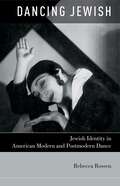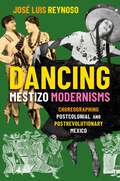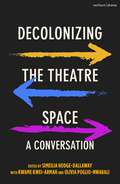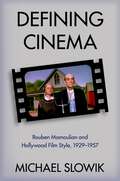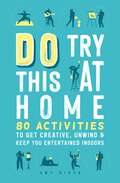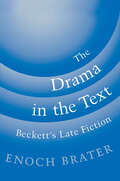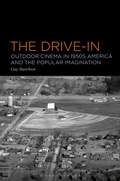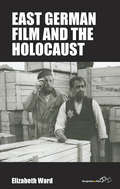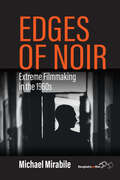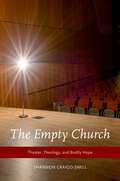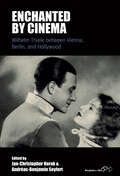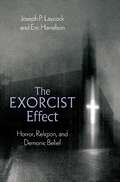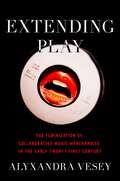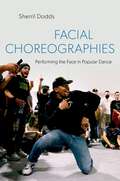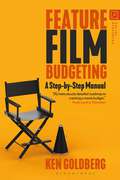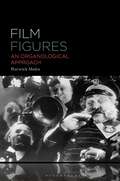- Table View
- List View
Dancing Mestizo Modernisms: Choreographing Postcolonial and Postrevolutionary Mexico
by Jose Luis ReynosoThis book analyzes how national and international dancers contributed to developing Mexico's cultural politics and notions of the nation at different historical moments. It emphasizes how dancers and other moving bodies resisted and reproduced racial and social hierarchies stemming from colonial Mexico (1521-1821). Relying on extensive archival research, choreography as an analytical methodology, and theories of race, dance, and performance studies, author Jose Reynoso examines how dance and other forms of embodiment participated in Mexico's formation after the Mexican War of Independence (1821-1876), the Porfirian dictatorship (1876-1911), and postrevolutionary Mexico (1919-1940). In so doing, the book analyzes how underlying colonial logics continued to influence relationships amongst dancers, other artists, government officials, critics, and audiences of different backgrounds as they refashioned their racial, social, cultural, and national identities. The book proposes and develops two main concepts that explore these mutually formative interactions among such diverse people: embodied mestizo modernisms and transnational nationalisms. 'Embodied mestizo modernisms' refers to combinations of indigenous, folkloric, ballet, and modern dance practices in works choreographed by national and international dancers with different racial and social backgrounds. The book contends that these mestizo modernist dance practices challenged assumptions about racial neutrality with which whiteness historically established its ostensible supremacy in constructing Mexico's 'transnational nationalisms'. This argument holds that notions of the nation-state and national identities are not produced exclusively by a nation's natives but also by historical transnational forces and (dancing) bodies whose influences shape local politics, economic interests, and artistic practices.
Daughters of Darkness (Devil's Advocates)
by Kat EllingerDaughters of Darkness (1971) is a vampire film like no other. Heralded as psychological high-Gothic cinema, loved for its art-house and erotic flavors, Harry Kümel's 1971 cult classic is unwrapped in intricate detail by writer Kat Ellinger to unravel the many mysteries surrounding just what makes it so appealing. This book, as part of the Devil’s Advocates series, examines the film in the context of its peers and contemporaries, in order to argue its place an important evolutionary link in the chain of female vampire cinema. The text also explores the film's association with fairy tales, the Gothic genre, and fantastic tradition, as well as delving into aspects of the legend of Countess Bathory, traditional vampire lore, and much more. The book contains new and exclusive interviews with director Harry Kümel and actress and star Danielle Ouimet.
Dawn of the Dead (Devil's Advocates)
by Jon TowlsonGeorge A. Romero’s Dawn of the Dead (1978) is celebrated both as a ‘splatter’ movie and as a satire of 1970s consumerism. One of the most financially successful independent films ever produced, Dawn of the Dead presented a strong vision to audiences of the time in terms of its excessive, often shocking violence. It challenged censorship internationally and caused controversy in the United States and the UK. The film created problems with distributors because of its length and its graphic content; with the MPAA who awarded it an ‘X’ in America (a rating usually reserved for pornography); with the BBFC in the UK who completely recut it; and in various European territories where it was released in several versions. Arguably, excess is at the heart of Dawn of the Dead, integral to its meaning: not only in its scenes of gore, its in-your-face social satire and its gaudy pop-kitsch style but in the production history of the film itself. This Devil’s Advocate explores the various ways in which Romero took Dawn of the Dead into areas of extremity during its scripting, production and distribution; and the responses of industry, censorship bodies, reviewers and audiences of the time to the film’s excesses. Taking the approach of a micro-historical study, Jon Towlson offers a close analysis of the film’s production context to explore the cultural significance of Dawn of the Dead as a ‘rebel text’ and an example of oppositional cinema.
Dead of Night (Devil's Advocates)
by Jez Conolly David BatesReleased a matter of days after the end of the Second World War and a dozen years ahead of the first full-blooded Hammer Horror, the Ealing Studios horror anthology film Dead of Night featured contributions from some of the finest directors, writers and technicians ever to work in British film. Since its release it has become evermore widely regarded as a keystone in the architecture of horror cinema, both nationally and internationally, yet for a film that packs such a reputation this is the first time a single book has been dedicated to its analysis. Beginning with a brief plot précis 'road map' in order to aid navigation through the film's stories, there follows a discussion of Dead of Night's individual stories, including its frame tale ('Linking Narrative'), a consideration of the potency of stillness and the suspension of time as devices for eliciting goose bumps, an appraisal of the film in relation to the very English tradition of the festive ghost story, and an analysis of the British post-war male gender crisis embodied by a number of the film's protagonists. The book includes a selection of rarely seen pre-production designs produced by the film's acclaimed production designer, Michael Relph.
Decolonizing the Theatre Space: A Conversation
by Simeilia Hodge-Dallaway Kwame Kwei-Armah Olivia Poglio-Nwabali2020 was a year in which global politics radically shifted, catalyzed by the Covid-19 pandemic and the #BlackLivesMatter movement. This book is a response to that year, asking: was it a moment or is it a movement, and what fundamental changes within the arts industry need to come out of this time? The book includes over 20 interviews with some of the most pioneering Black cultural leaders from a wide range of senior executive positions in the arts within the UK, Europe, US and Africa. It documents the sea of change in arts leadership at the height of the #BlackLivesMatter movement, the pressure on organizations to confront and change their racial and ethnic make-up, and shines a light on the guiding ambitions, strategic plans and visions for the future to support the ongoing decolonization of arts organizations across the world. Learn from those who have walked the walk to support your vision for the future.
Defining Cinema: Rouben Mamoulian and Hollywood Film Style, 1929-1957 (Oxford Music / Media)
by Michael SlowikArriving in cinema when synchronized sound had just been adopted, director Rouben Mamoulian demonstrated key early methods for making sound aid storytelling, for giving films a crisper sense of rhythm, for creating musicals set in backstage, fairy-tale, and folk environments, for providing intricate and arresting colour palettes, and for rendering sexual content more palpable under industry censorship. Mamoulian also wrote many articles throughout his lifetime and gave interviews and lectures where he advanced his complex ideas about the potentials of various artforms, including cinema. In addition, he left an extensive paper record of his work, including heavily annotated scripts for each of the sixteen films he directed. Mamoulian also enjoyed major success on the stage. He directed the original landmark productions of Porgy, Porgy and Bess, Oklahoma!, and Carousel, and his efforts in this domain informed his film work. Defining Cinema takes a holistic look at Mamoulian's oeuvre by examining both his stage and his screen work, and also brings together insights from his correspondence, his theories on film, and analysis of the films themselves. It presents a filmmaker whose work was innovative and exciting, who pushed hard on cinema's potential as an artform, and who in many ways helped move cinema towards the kind of entertainment that it remains today. The book thus tells a story that is vital not just for better understanding the work of a neglected filmmaker, but for anyone interested in the history of Hollywood filmmaking.
The Descent (Devil's Advocates)
by James MarriottThe story of an all-female caving expedition gone horribly wrong, The Descent (2005) is arguably the best of the mid-2000s horror entries to return verve and intensity to the genre. Unlike its peers (Saw [2004], Hostel [2011], etc.), The Descent was both commercially and critically popular, providing a genuine version of what other films could only produce as pastiche. For Mark Kermode, writing in the Observer, it was "one of the best British horror films of recent years," and Derek Elley in Variety described it as "an object lesson in making a tightly-budgeted, no-star horror pic." Time Out's critic praised "this fiercely entertaining British horror movie;" while Rolling Stone's Peter Travers warned prospective viewers to "prepare to be scared senseless." Emphasizing female characters and camaraderie, The Descent is an ideal springboard for discussing underexplored horror themes: the genre's engagement with the lure of the archaic; the idea of birth as the foundational human trauma and its implications for horror film criticism; and the use of provisional worldviews, or "rubber realities," in horror.
The Devils (Devil's Advocates)
by Darren ArnoldUndoubtedly the most notorious title in director Ken Russell’s controversial filmography, The Devils (1973) caused a real furor on its initial theatrical release, only to largely disappear for many years. This Devil’s Advocate considers the film’s historical context, as the timing of the first appearance of The Devils is of particular importance, its authorship and adaptation (Russell’s auteur reputation aside, the screenplay is based on John Whiting’s 1961 play of the same name, which was in turn based on Aldous Huxley’s 1952 book The Devils of Loudun), and its generic hybridity. Darren Arnold goes on to examine the themes prevalent in the film—this is the only film of Russell’s which the director considered to be political—and considers the representation of gender and sexuality, gender fluidity, and how sex and religion clash to interesting and controversial effect. He concludes by revisiting the film’s censorship travails and the various versions of The Devils that have appeared on both big and small screens, and the film’s legacy and influence.
Do Try This at Home: 80 Activities to Get Creative, Unwind and Keep You Entertained Indoors
by Amy BirchStaying at home doesn’t mean that you have be stuck in front of the TV. This is the ultimate companion to help you beat boredom and to embrace your time indoors.Organized by mood, this book is packed with ideas on how to energize yourself, find your purpose, relax and reflect, get creative and connect with the world around you. Whether it’s for a rainy day or a weekend indoors, there are over 80 ideas to keep busy and to challenge your mind. Staying at home can be a challenge and this clever book will offer ways to keep you happy and healthy, from putting together a homemade exercise routine using everyday household items to creating your own home silent disco as well as ideas to help you discover a new hobby, such as learning a language or upcycling furniture. There are also tasks to keep you feeling engaged and proactive, with tips on lowering your plastic pollution and ways you can volunteer from the comfort of your home, as well as practical ways to help you stay connected with nature, from making your own bird feeder to star gazing from your window, and creative activities to help reduce stress and worry, such as journaling, colouring and crafting. Staying in is the new going out, and it’s so much more fun when you have ideas to keep you busy and entertained. These simple activities are full of tips and tricks to make your time at home as enjoyable as possible. You’ll never wonder what you can do with your spare time ever again!
Doing Text: Media After the Subject (Auteur)
This collection re-imagines the study of English and media in a way that decentralises the text (e.g. romantic poetry or film noir) or media formats/platforms (e.g. broadcast media/new media). Instead, the authors work across boundaries in meaningful thematic contexts that reflect the ways in which people engage with reading, watching, making, and listening in their textual lives. In so doing, this project recasts both subjects as combined in a more reflexive, critical space for the study of our everyday social and cultural interactions. Across the chapters, the authors present applicable learning and teaching strategies that weave together art works, films, social practices, creativity, 'viral' media, theater, TV, social media, videogames, and literature. The culmination of this range of strategies is a reclaimed 'blue skies' approach to progressive textual education, free from constraining shackles of outdated ideas about textual categories and value that have hitherto alienated generations of students and both English and media from themselves.
Don't Look Now (Devil's Advocates)
by Jessica GildersleeveNicolas Roeg's Don't Look Now (1973) has been called "a ghost story for adults." Certainly, in contrast to the more explicitly violent and bloodthirsty horror films of the 1970s, Don't Look Now seems of an entirely different order. Yet this supernaturally inflected tale of a child's accidental drowning, and her parents' desperate simultaneous recoil from her death and pursuit of her ghost, Don't Look Now is horrific at every turn. This book argues for it as a particular kind of horror film, one which depends utterly on the narrative of trauma—on the horror of unknowing, of seeing too late, and of the failures of paternal authority and responsibility. Jessica Gildersleeve positions Don't Look Now within a discourse of midcentury anxiety narratives primarily existing in literary texts. In this context, it represents a cross over or a hinge between literature and film of the 1970s, and the ways in which the women's ghost story or uncanny story turns the horror film into a cultural commentary on the failures of the modern family.
The Drama In The Text: Beckett's Late Fiction
by Enoch BraterThe Drama in the Textargues that Beckett's late fiction, like his radio plays, demands to be read aloud, since much of the emotional meaning lodges in its tonality. In Beckett's haunting prose work the reader turns listener, collaborating with the sound of words to elucidate meaning from the silence of the universe. Enoch Brater ranges across all of Beckett's work, quoting from it liberally, and makes connections mainly with other writers, but also with details drawn from the entire Western cultural heritage. Brater serves as an authoritative and persuasive guide to the rich texture of such a difficult but compelling vocabulary, providing recognition, insight, and accessibility.
The Drive-In: Outdoor Cinema in 1950s America and the Popular Imagination
by Dr Guy BarefootThe Drive-In meaningfully contributes to the complex picture of outdoor cinema that has been central to American culture and to a history of US cinema based on diverse viewing experiences rather than a select number of films. Drive-in cinemas flourished in 1950s America, in some summer weeks to the extent that there were more cinemagoers outdoors than indoors. Often associated with teenagers interested in the drive-in as a 'passion pit' or a venue for exploitation films, accounts of the 1950s American drive-in tend to emphasise their popularity with families with young children, downplaying the importance of a film programme apparently limited to old, low-budget or independent films and characterising drive-in operators as industry outsiders. They retain a hold on the popular imagination. The Drive-In identifies the mix of generations in the drive-in audience as well as accounts that articulate individual experiences, from the drive-in as a dating venue to a segregated space. Through detailed analysis of the film industry trade press, local newspapers and a range of other primary sources including archival records on cinemas and cinema circuits in Arkansas, California, New York State and Texas, this book examines how drive-ins were integrated into local communities and the film industry and reveals the importance and range of drive-in programmes that were often close to that of their indoor neighbours.
East German Film and the Holocaust (Film Europa #22)
by Elizabeth WardEast Germany’s ruling party never officially acknowledged responsibility for the crimes committed in Germany’s name during the Third Reich. Instead, it cast communists as both victims of and victors over National Socialist oppression while marginalizing discussions of Jewish suffering. Yet for the 1977 Academy Awards, the Ministry of Culture submitted Jakob der Lügner – a film focused exclusively on Jewish victimhood that would become the only East German film to ever be officially nominated. By combining close analyses of key films with extensive archival research, this book explores how GDR filmmakers depicted Jews and the Holocaust in a country where memories of Nazi persecution were highly prescribed, tightly controlled and invariably political.
Edges of Noir: Extreme Filmmaking in the 1960s
by Michael MirabileEdges of Noir challenges the notion that noir film nearly vanished after 1958 until its subsequent “neo-noir” revival between 1973 and 1981. The 1960s, regardless of critical neglect, include some of the most provocative films of the post-World War II decades. Often formally disruptive and experimental, films including Shock Corridor (1963), Mirage (1965), The 3rd Voice (1960), and Point Blank (1967) evoke controversial issues of the era, deriving dynamic influences amongst exploitation cinema, sensationalistic American B movies, and the European New Wave movement. Whether the focus is on nuclear destruction, mind control, or surveillance, late noir films, above all else, vividly portray the collective fears from the time.
Enchanted by Cinema: Wilhelm Thiele between Vienna, Berlin, and Hollywood (Film Europa #29)
by Jan-Christopher Horak Andréas-Benjamin SeyfertWilliam Thiele is remembered today as the father of the sound film operetta with seminal classics such as Drei von der Tankstelle (1930). While often considered among the most accomplished directors of Late Weimar cinema, as an Austrian Jew he was vilified during the onset of the Nazi regime in 1933 and fled to the United States where he continued making films until the end of his career in 1960. Enchanted by Cinema closely examines the European musical film pioneer’s work and his cross-cultural perspective across forty years of filmography in Berlin and Hollywood to account for his popularity while discussing issues of ethnicity, exile, comedy, music, gender, and race.
The Evil Dead (Devil's Advocates)
by Lloyd HaynesSam Raimi’s The Evil Dead (1981) is one of the most inventive and energetic horror movies of the last 40 years. Released during a period in which the stalk-and-slash cycle had blunted the horror genre of much of its creative edge, Raimi’s debut feature transcends its small budget and limited resources to deliver a phantasmagoric roller-coaster ride, a wildly absurd and surreal assault on the senses. Still original enough to stand on its own and be considered as a genre classic, this book will explain its long-lasting appeal and impact. After detailing the unique circumstances of its origin, Lloyd Haynes goes on to analyse key aspects of the film’s abiding success. The Evil Dead is one of a number of horror films which locate their terrors in a single setting and limited time frame. Haynes argues that it creates a ‘bad dream’ effect in which the nightmare is never-ending and increasingly horrific, and how the cabin-in-the-woods location is also a fine example of the ‘bad place’ motif which stretches back to the Gothic novels of the 18th century. The book goes on to consider what character traits Ash Williams, The Evil Dead’s ‘macho’ male hero, shares with Carol Clover’s ‘Final Girl’ model and how effective he is as a ‘Final Guy’. Finally, it explores the critical approaches to the film, in particular its notorious reputation in Britain as a ‘video nasty’.
The Exorcist Effect: Horror, Religion, and Demonic Belief
by Joseph P. Laycock Eric HarrelsonThe Exorcist Effect is a fascinating historical study of the ongoing relationship between horror movies and Western religious culture, with a focus on the period from 1968 to the modern day. Taking its name from the 1973 film The Exorcist, which was widely understood to be based on a true story, this book outlines a cycle in which religious beliefs and practices become the basis of films that in turn inspire religious beliefs, practices, and experiences in response. Authors Joseph P. Laycock and Eric Harrelson draw heavily from archival research to shed new light on the details of this phenomenon, in addition to incorporating interviews with horror authors, film writers, and paranormal investigators. Drawing on psychology, sociology, and folklore studies, Laycock and Harrelson theorize how film informs religious experience and shapes religious culture. The Exorcist Effect examines the production and reception of Rosemary's Baby (1968), The Exorcist (1973), and The Omen (1976) as seminal films in the genre; figures as Malachi Martin as well as Ed and Lorraine Warren, who inserted themselves directly into the spotlight, and the horror films that influenced and were inspired by their careers; and areas of culture where the influence of this cycle was most apparent-the Satanic Panic, religious exorcisms, and moral panic over heavy metal and the messages it was purported to spread. The final chapter considers the QAnon conspiracy theory and its numerous allusions to film as a contemporary manifestation of ?The Exorcist effect.? Ultimately, The Exorcist Effect is a deftly researched and compelling volume that is sure to interest horror buffs, religious scholars, and historians alike.
Extending Play: The Feminization of Collaborative Music Merchandise in the Early Twenty-First Century
by Alyxandra VeseyDespite the hypervisibility of a constellation of female pop stars, the music business is structured around gender inequality. As a result, women in the music industry often seize on self-branding opportunities in fashion, cosmetics, food, and technology for the purposes of professional longevity. Extending Play examines the ubiquity of brand partnerships in the contemporary music industry through the lens of feminized labor, to demonstrate how female artists use them as a resource for artistic expression and to articulate forms of popular feminism through self-commodification. In this book, author Alyxandra Vesey examines this type of promotional work and examines its proliferation in the early 21st century. Though brand partnerships exist across all media industries, they are a distinct phenomenon for the music business because of their associations with fan club merchandise, concert merchandise, and lifestyle branding, often foregrounding women's participation in shaping these economies through fan labor and image management. Through textual and discourse analysis of artists' songs, music videos, interviews, social media usage, promotional campaigns, marketing strategies, and business decisions, Extending Play investigates how female musicians co-create branded feminine-coded products like perfume, clothes, makeup, and cookbooks and masculine-coded products like music equipment as resources to work through their own ideas about gender and femininity as workers in industries that often use sexism and ageism to diminish women's creative authority and diminish the value of the recording in order to incentivize musicians to internalize the demands of industrial convergence. By merging star studies, popular music studies, and media industry studies, Extending Play proposes an integrated methodology for approaching contemporary cultural history that demonstrates how female-identified musicians have operated as both a hub for industrial convergence and as music industry professionals who use their extramusical skills to reassert their creative acumen.
Eyes Wide Shut: Behind Stanley Kubrick's Masterpiece (Stanley Kubrick Studies)
Twenty years after its release, Stanley Kubrick's Eyes Wide Shut remains a complex, visually arresting film about marriage, jealousy, domesticity, adultery, sexual disturbance, and dreams. This was the final enigmatic work from its equally enigmatic creator. It has left an indelible mark on our popular culture and remains as relevant as ever. Much maligned and much misunderstood when it first came out, Eyes Wide Shut has since been the subject of an animated debate and discussion among critics, fans and academics. It has been explored from a wide variety of disciplines and methodological perspectives. This collection brings scholars from diverse disciplinary backgrounds together with those who worked on the film to explore Eyes Wide Shut’s legacy, discuss its impact, and consider its position within Kubrick’s oeuvre and the wider visual and socio-political culture.
Facial Choreographies: Performing the Face in Popular Dance
by Sherril DoddsThe face contributes a vital, yet often overlooked, component of dance performance. Facial Choreographies: Performing the Face in Popular Dance examines what the face does in dance and what it may mean. Author Sherril Dodds focuses on popular presentational dance, which permits the face to be one of excess and spectacle, as well as disclosure or deception. The concept of facial choreography resists the idea that the expressive countenance in dance is simply by chance, and instead conceives its movement as purposeful, creative, and communicative. The book centers on three facial case studies: global celebrity Michael Jackson, whose face has occupied a site of fervent controversy; Maddie Ziegler, child star of the reality television series Dance Moms and de facto face of pop star Sia; and a community of hip hop dancers who engage in fiercely contested dance battles. Chapters are organized according to action-expressions, actively working even in times of stillness: SMILE, LOOK, FROWN, CRY, SCREAM, and LAUGH. Across each case study, the book explores pedagogies of facial composition, the purpose of codified expressions, and how dancers re-choreograph their faces as a critical unworking of what a dancing visage might represent. Facial choreographies engender opportunity for startling creativity, the articulation of identity, a cathartic expression of emotions and attitudes, and the capacity to dismantle previously held assumptions. As the dancing face tauntingly slips between visual, sensory, and kinetic registers it ensures that nothing can be taken at face value.
Feature Film Budgeting: A Step-by-Step Manual
by Ken GoldbergFeature Film Budgeting: A Step-by-Step Manual is a step-by-step guide to film budgeting in the $600k to $6.5 Million range. Be it the film student, Line Producer, 1st Assistant Director, or script writer, all will benefit from the easy-to-follow steps on how to create a film budget. This book walks the reader through how to:- find current and future salary rates for every Hollywood Guild- determine Prep and Wrap periods for all crew members- navigate the Guild contracts for easy understanding- analyze salary rates and how they were arrived at- simplify the application of fringe rates (tax percentages). Additionally, sample budgets are presented to reinforce knowledge gained in each chapter through a comprehensive breakdown. Notably, this manual covers films budgeted in the $600,000 to $6.5 Million range. This allows the reader to focus and excel at those budget levels before moving on to higher budget levels.
Film Figures: An Organological Approach
by Warwick MulesFilm Figures develops a figural account of the memory structure of films.Employing theoretical concepts drawn from a range of sources, including French post-humanist philosophy and German Idealism, the book undertakes an organology of film guided by the work of Bernard Stiegler whose philosophy of mnemotechnesis provides the framework of analysis. Situating films in the quantum field of spacetime relativity as a field of cosmic views, inquiry into film figures begins with disturbances in the experience of films themselves, posing questions of the relation between the dead past and the living future in film story-telling. By breaking the façade of the continuing present through self-questioning, we open films to their figural dimensions in the counter-movement of drive as negentropic resistance. Following the back-movement of drive switches our perception to the figural register in which characters become figures probing blindly for what the film will have been in another time – a time yet to be lived. By following the anterior possibilities of this other time, we open films to the archival future in which a new future comes forth. This book provides theoretical and analytical concepts as well as strategies for taking a step into this future, guided by questions of the right path to take given the relativity of views in which the film can be experienced. Films analysed include Murnau's The Last Laugh, Capra's It's a Wonderful Life, Hitchcock's Rear Window, Welles's The Lady from Shanghai, Fellini's Intervista, Antonioni's L'Eclisse, Bresson's Une Femme Douce, and Zeller's The Father.
